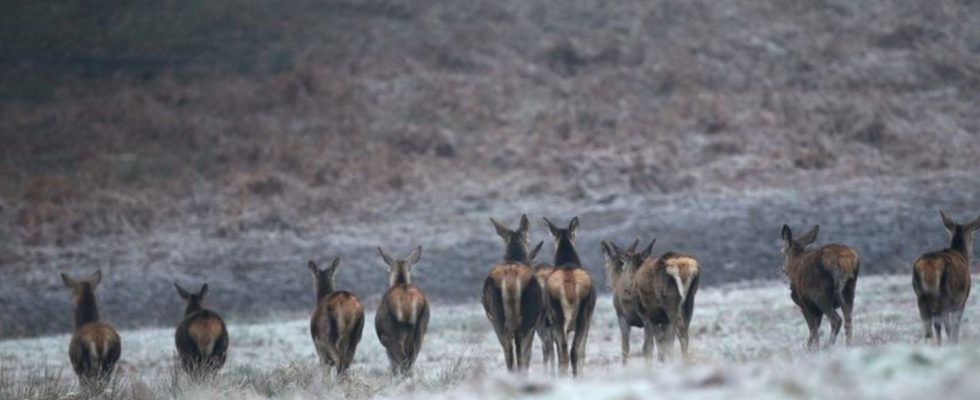Animals
Deer and roe deer are a concern for Britain
Deer in a frost covered field in Richmond Park, London. photo
© Yui Mok/PA Wire/dpa
In the Highlands they are eating up the slopes bare, drivers and farmers are complaining about damage: Great Britain is struggling with its deer. It is estimated that the population has increased to two million animals.
The historical comparison is tough. Even in the time of William the Conqueror there weren’t that many in Britain Given deer, the Sun newspaper was astonished. That was – an important date in British history – in the year 1066.
Almost 1,000 years later, it is estimated that more than two million individuals roam Britain’s fields and hills. More and more experts are warning that things cannot continue like this: “Bambi” is threatened with being shot down en masse. But there is another suggestion – it goes through the stomach.
The game comes to the table
“Now thousands of kindergarten children are joining the fight to control Britain’s rising number of deer – by eating them for lunch,” the Times wrote martially. Tops Day Nurseries was one of the first educational institutions to put game on the menu for the 4,000 children it cares for in the south of England. Five dishes have been created together with the Eat Wild industry initiative, and game will be served twice within three weeks – that’s 3,000 meals a month.
In English, “Deer” is the generic term for the entire deer family. These include red and fallow deer as well as roe deer. Catering chef Pete Ttofis raves about the variety of dishes. The meat has not been treated with growth hormones or antibiotics, but comes directly from the natural habitat. Game dishes are not only considered rich in nutrients and vitamins, but also more sustainable than chicken and pork.
As the Sun reported, there are also considerations to encourage supermarkets to sell more venison. This could reduce prices – an opportunity for healthy meat for many people who complain about high energy and food costs. “The deer population is out of control,” says Eat Wild boss Louisa Clutterbuck. “Therefore there is no supply problem at all, there is an oversupply at the moment.”
The deer have no natural enemies
The enormous population has consequences: Farmers lose crops worth millions of pounds every year to deer. In Scotland they prevent widespread reforestation. 75,000 wildlife accidents per year cause vehicle damage of around 45 million pounds (52.6 million euros) – and cost around 10 to 15 people their lives per year. The animals can also transmit diseases.
There are several reasons for the boom. “Deer previously wouldn’t have had a chance in rural areas because people were hungry,” Paul Dolman from the University of East Anglia told the BBC. “Now people no longer live off the land, so deer have a much greater chance of survival.” In addition, the animals in Great Britain have no natural enemies. Wolves and bears have not been around for a long time and, unlike lynxes, there are no plans to reintroduce them.
Mild winters lead to increased fertility
“Everything speaks for the deer,” says Peter Watson from the organization Deer Initiative. “Forest cover has increased and farmers grow crops all year round.” Winter fruits during times when there was otherwise little forage are a source of food.
Milder winters due to climate change would contribute to increased animal fertility, Watson said. The fact that demand from restaurants fell significantly during the pandemic is another reason for the steep population increase: an estimated 80 percent of the deer shot previously went to the catering industry.
The industry is hoping for a turnaround. A major factor in controlling populations is the price hunters can obtain. If the demand for venison increases, they could be encouraged to shoot more.
So far, around 350,000 animals are shot every year. Far too little, say experts. Up to 750,000 kills are necessary. Conservationists would classify a population of less than a million as sustainable to reduce economic and environmental impacts, the Times reported.

